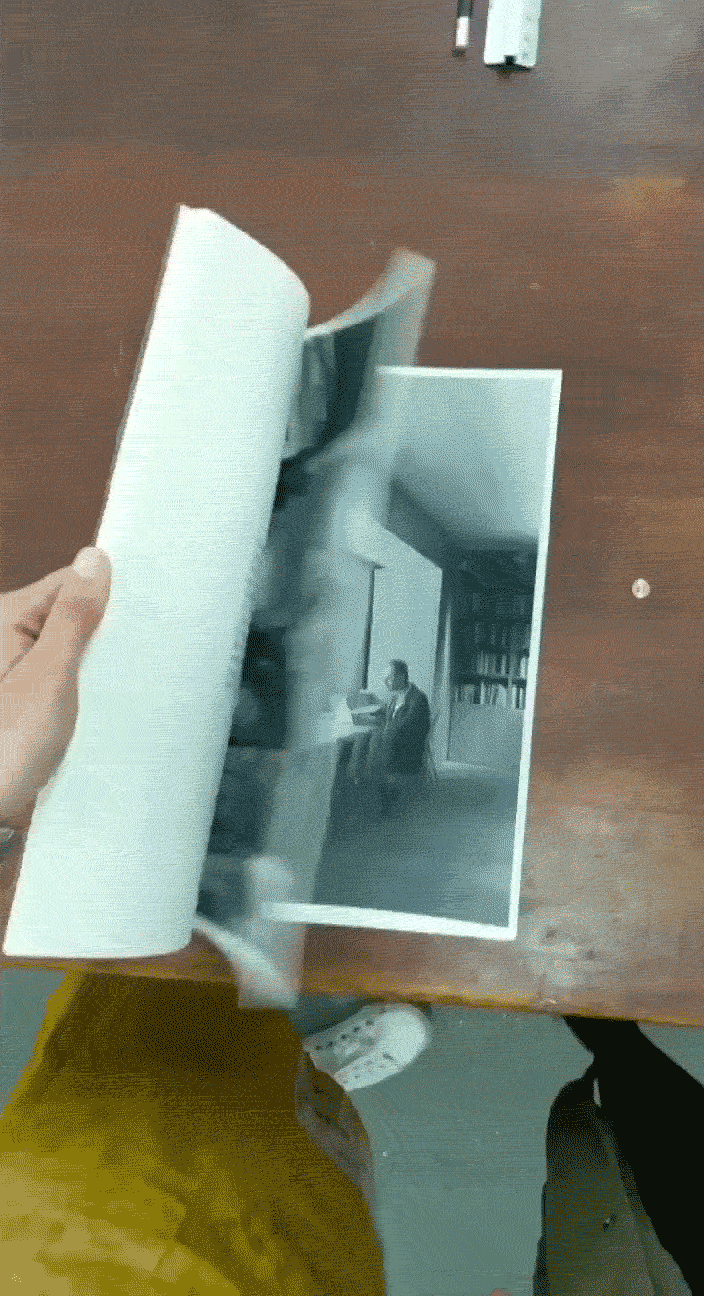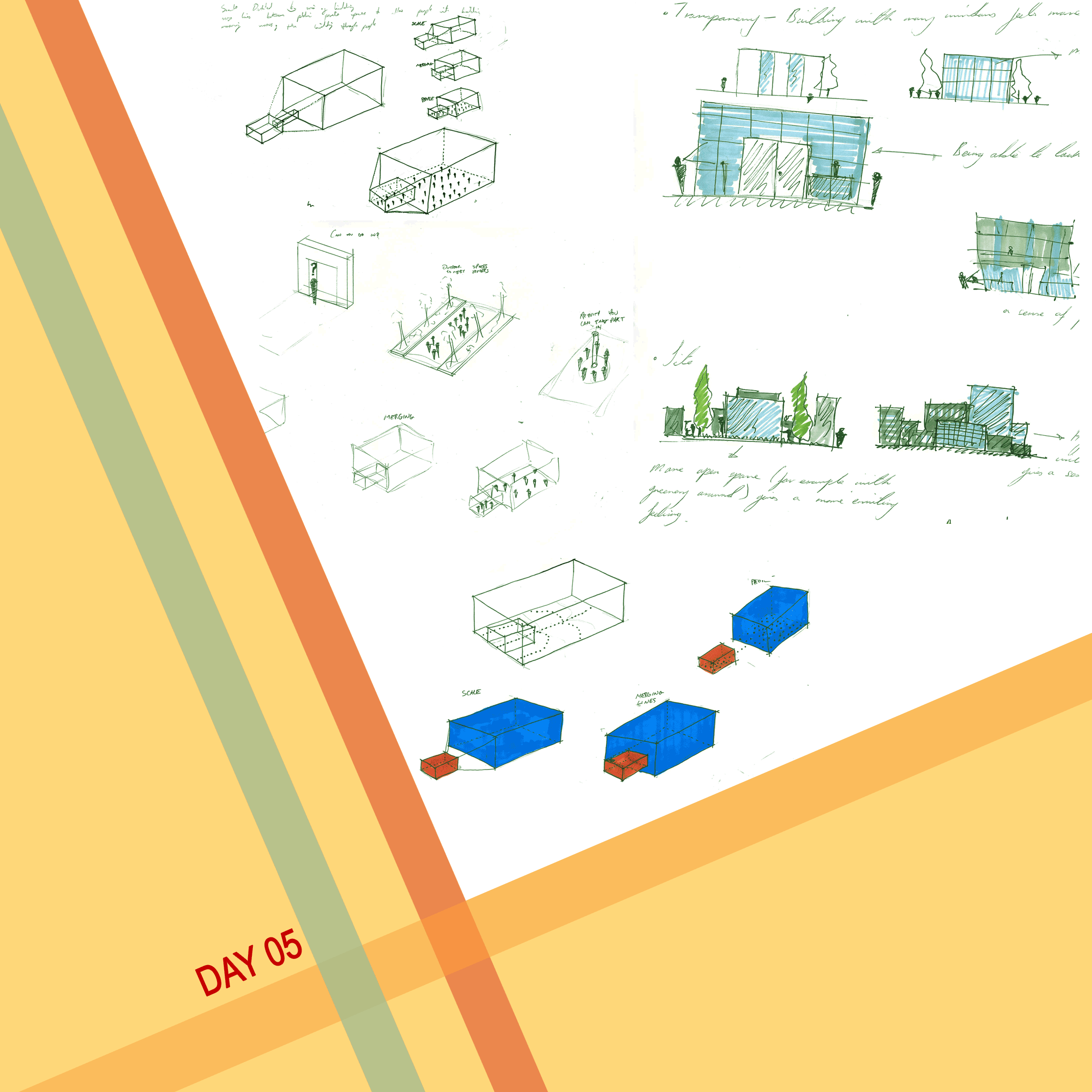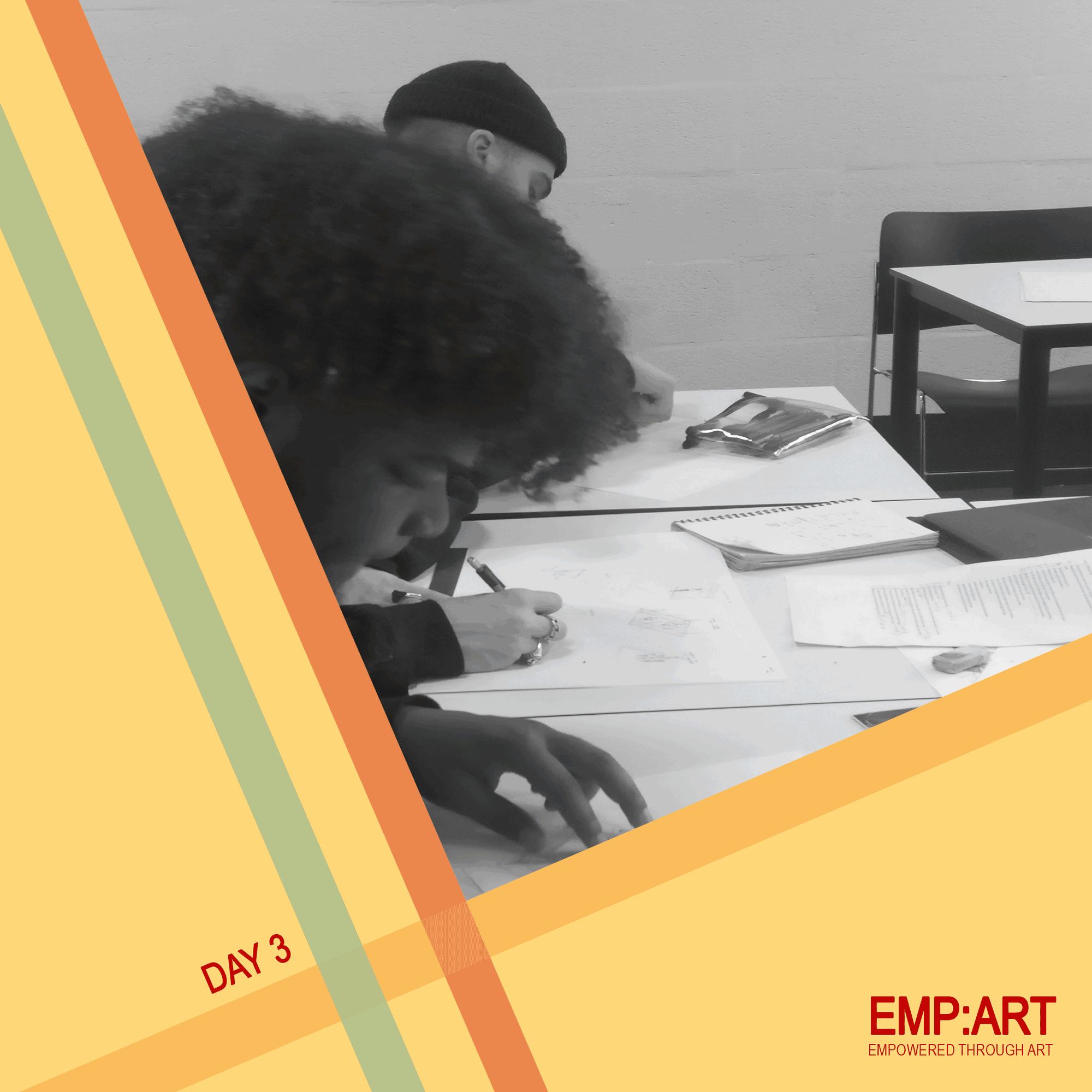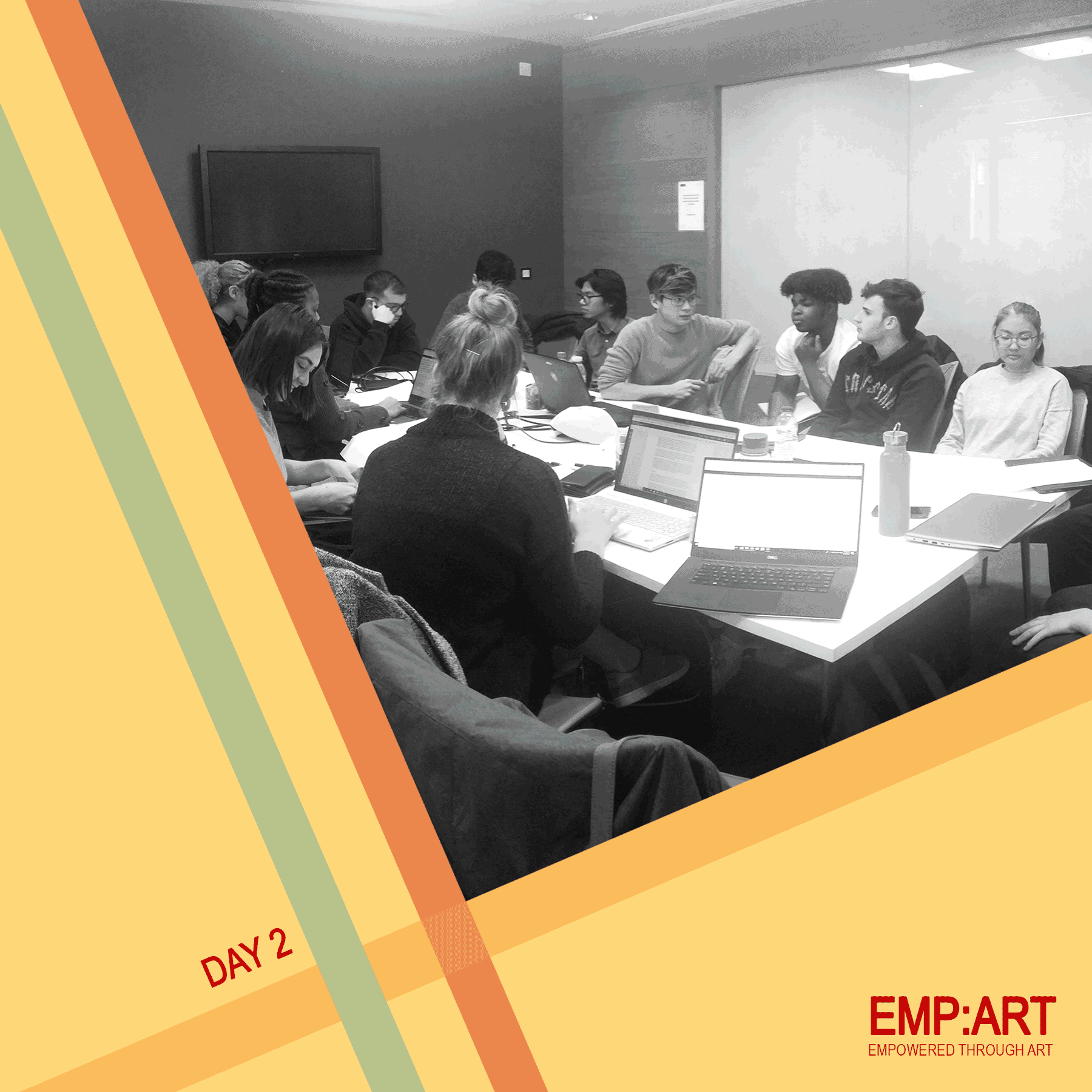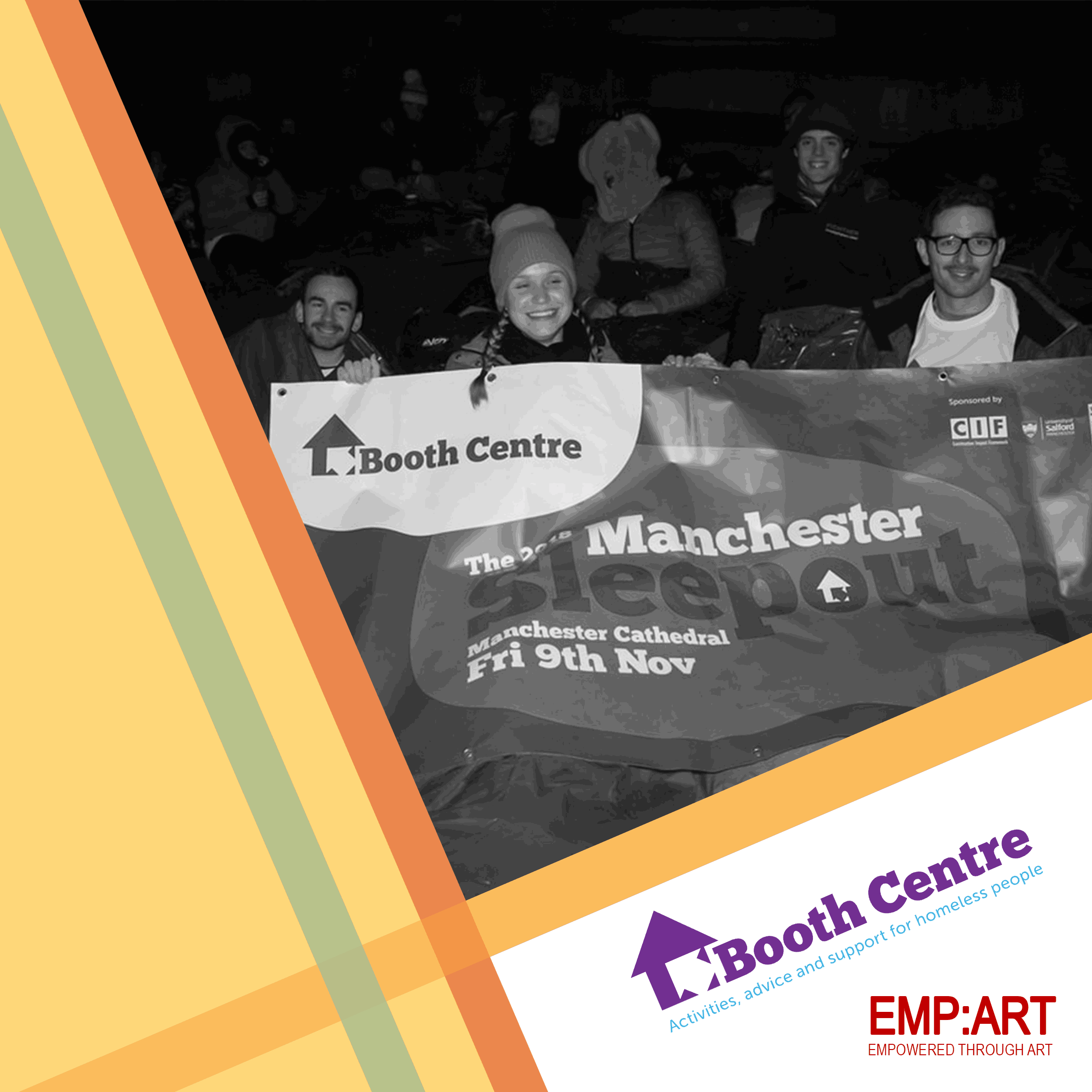The 'Cultural Spaces and Homelessness Design Handbook' is the final output of our two week event. This is primarily an online document and will be published on the With One Voice website as a design guide for inclusive cultural spaces, both existing and new.
Group AE EMP:ART
EMPOWERED THROUGH ART. An MSA and With One Voice collaboration. The aim of this collaboration is to integrate people who are or have previously been homelessness into the cultural spaces that populate the city through the arts. With one voice is an organisation that believes in giving a voice to the homeless community through this same medium. They organise exchanges between the arts, homeless organisations and policy makers across the world and support new initiatives and projects that are aimed towards similar goals. The event will include design proposals for a variety of cultural sites in the city that will eventually contribute to the production of a downloadable design guide to improve such spaces. // Download Poster
Purva B // Chelsea B // Simisola A // Olivia M // Celeste A
The 'Cultural Spaces and Homelessness Design Handbook' is the final output of our two week event. This is primarily an online document and will be published on the With One Voice website as a design guide for inclusive cultural spaces, both existing and new.
This map locates cultural spaces that have the potential to welcome people who are or have been homeless and can be a valuable source of information for those seeking temporary shelter. The development of this network is also a means to ensure that gradually, all such spaces are designed/modified to be more inclusive.
As part of our design handbook, we have proposed a cultural spaces inclusivity badge that allows cultural spaces to be recognised as inclusive spaces. The simple design is an easy way for members of the public to recognise any building that is part of the inclusive cultural spaces network.
Today was focused on finalising the design guide. The first and second year students created the final diagrams that elaborate on points such programme of space, flexibility and wayfinding.
We are progressing with the compilation of our design guide by producing graphics and illustrations for each of the factors we are addressing.
4. Way-Finding
Legibility is necessary to help people find out where they are and identify where they’re going. Creating different routes and experiences towards and into the building can create a welcoming atmosphere. Subtle signage with creative alternatives to physical signs can be used such as variations in paving, plants, lighting, etc.
5. Programme
Thinking about the programme for the public space around the building and it’s uses for the public allows for the space to be designed with activities for everyone in mind. Positioning the reception and any front of house communication in front of the entrance may seem ideal but can be intimidating for people who are unsure of whether they belong there.
We are progressing with the compilation of our design guide by producing graphics and illustrations for each of the factors we are addressing.
3. Blurring Thresholds
Greenery has a great impact in making a space appear more welcome, acting a break from the urbanisation we live in today. Blurring the divide between the inside and the outside, especially with landscaping maintains a continuity, giving people a chance to leave the confinement of the built form while still being "inside" it.
We are progressing with the compilation of our design guide by producing graphics and illustrations for each of the factors we are addressing.
1. Transparency
Making sure that it is possible to see into and from inside the building, not only gives a glimpse of what the building has to offer but also reduces the sense of confinement that can make people reluctant to enter the space.
2. Flexibility
It is necessary to ensure that cultural spaces are suitable to host a range of activities that encourage public participation. Flexibility is key in enabling people to personalise these spaces and use them as they wish. Such activity is bound to draw attention, increasing the building’s footfall in the process.
Following the informative workshop with the consultation group and staff at the Manchester Museum, we have moved on to working on the content of the design guide that is to be presented to the external collaborators on Friday.
Working in a variety of graphic styles, today’s session was focused on producing visuals that are representative of the points that came out of yesterday’s session. Our main aims were to produce a map that establishes a route for inclusive cultural spaces in Manchester, develop conceptual models of one possible entrance to Manchester Museum, and to collate sketches based on the case study research.
In the second part of our Manchester Museum visit we worked in three groups, mixed with museum staff, the consultation group from last Monday and the MSA students. We discussed the points raised about the entrance, foyer and threshold in last weeks events and how they could possibly be applied to future developments at the museum.
We were fortunate enough to be given a tour around the closed section of the museum that is currently under renovation followed by a session with mixed groups consisting of undergraduates, the consultation group and staff. Some of the points raised were:
Approach
• The importance of connecting the inside and outside with enough room for people to gather their thoughts and perhaps the 'courage' to enter
Threshold
• Designing on levels to cater to a wider group of people
• The possibility of including a space between the inside and the outside to act as a buffer
Foyer
• The importance of having flexible spaces within the foyer
• How we can use parts of the collection to create interest and bring people into the space
We would like to thank With One Voice, Manchester Museum and the consultation group for having us and providing valuable information!
We were fortunate to be given a tour of the closed section of Manchester Museum that is currently under renovation. The staff were able to give us insights into their new entrance, lobby and foyer spaces, new exhibition and cafe spaces.
Kal Gill-Faci, head of corporate engagement at the Pledge charity in Manchester, joined us for the presentation on Friday afternoon along with John Edwards, from our collaborator Laing O’Rourke. We discussed the process we followed through the week starting with the consultation with people who have been homeless on Monday, the site visits to the Art Gallery, Central Library and Castlefield Gallery on Tuesday, development of sketches of Wednesday, consultation with Adam Ash from Plincke on Thursday and the final illustrations on Friday. Based on the discussions regarding the importance of the approach, threshold and foyer in making people feel welcome, we presented a series of 4-6 key points that could be implemented in almost all designs.
The general feedback we received was to include our intensive process in the guide and combine the sketchbook with the analysis of our case studies. We are also looking into providing solutions for the shortcomings we identified in the buildings we visited.
The schedule for the morning involved completing and compiling the undergraduates diagrams that they had started to create towards the later part of the week. We are excited to present these to our collaborators in the afternoon!
The schedule for the afternoon included a study of the initial sketches the undergraduate students had come up with during the first half of the week in response to the design discussion with the consultation groups. This proved vital in developing computerised illustrations for the final publication and identifying case studies that accommodated these elements of inclusiveness. Based on the morning’s session, we identified three parts to our document. The first will be a sketchbook that documents all the initial drawings through our consultations, site visits and brainstorming sessions. The second will be the developed guide itself. The third and final component will illustrate these guidelines in the context of Manchester Museum during our site visit on the 1st of April.
Adam Ash from Plincke, a landscape architecture and urban design practice, joined us this morning, with John Edwards from Laing O’Rourke, to speak to us about the different ways in which public spaces could be made inclusive. Interactive art installations, game areas, bench dining and interspersed with covered spaces are all effective in reclaiming public space for the people.
The group then split up into two to speak to Adam and John about identifying themes to include in the final publication. The themes that we identified include:
-A multi-disciplinary team including an architect, landscape architect, engineer, lighting designers, members of the wider city infrastructure team and most importantly a consultation group that includes the final users to ensure that while the building is not active 24/7 the landscape outside can be.
- The importance of soft and hard landscape.
- Timetabling of the spaces so that working hours can be extended for certain parts of the building.
- Innovative way-finding methods that are more than just signboards.
- Blurring of the outside and the inside to make spaces more flexible.
- Community spaces in the front that remove the need for additional security measures at the entrances.
- Roof gardens to include green spaces in a dense urban environment.
We’re grateful to Adam for coming in today and helping define the direction in which the final document will be moving.
Subsequent to yesterdays site visits to Manchester Art Gallery, Manchester Central Library and Castlefield Gallery; the students have split into two groups. One brainstorming and highlighting the positives and negatives of the cultural spaces that we visited yesterday. The second, are formulating computerised diagrams formed from initial ideas of strategies that could be applied to these spaces. We also have had a positive software training session for individuals who wanted to improve their existing software skills.
We are excited to see what the undergraduates produce in terms of initial ideas!
Following discussions with the consultation group, we began the day by exploring how some of the themes could be communicated visually through the use of sketches and diagrams. Our meeting with the consultation group clarified the difference between the cultural and architectural barriers that are encountered in cultural spaces.
The groups were split into smaller groups working on the themes of how the approach, entrance and foyer area of a cultural building could be designed to be more inclusive for members of the public who are or have been homeless.
Once ideas were fed back to the larger group, the second half of the day was spent on a site visit to Manchester Art Gallery, Manchester Central Library and Castlefield Gallery. The site visits provided an opportunity to gain greater insight into the role of cultural spaces and to speak to members of staff. As a group, we analysed existing strategies within these spaces and looked at how solutions concerning the approach, entrance and foyer could be applied to these buildings.
Today we met with Matt, Fee, Cookie and Gareth from With One Voice, John with Laing O’Rourke and Simon, John and Norman from Manchester Street Poem to discuss the possibilities and challenges of existing cultural spaces.
We started the discussions by talking about everyone’s experiences of cultural spaces in and around Manchester. The question everyone asked themselves when they entered the buildings was ‘can we go in?’ and a few common points raised were:
- Immediate barriers in terms of security on the front door were unwelcoming
- Misuse of signage inside and outside is confusing and off putting
- There should be wi-fi access to draw you in
- Transparency is important, being able to see in and out as well as being able to see certain collections the space has
- There should be outdoor spaces to meet others that contain benches
- Symbols, logos and pictures are much preferred over lots of text
We then went on to look more specifically at the approach, entrance and foyer of these spaces and will be looking at these aspects in the case study trips tomorrow afternoon.
We would like to thank everyone who came today for their helpful contributions.
The day began with an ice-breaker session with the BA students, introducing them to the project, its aims and outputs.
This was followed by a rendezvous with Dominic Sagar and the other EVENTS groups, “Art+Garden+Life” and “Are You Aware”, dealing with various aspects of homelessness. Representatives from organisations such as Mustard Tree, Street Poem, Herblabism and Cracking Good Food were present to discuss with us their work in this field. The session was eye-opener, bringing up a multitude of issues faced by people who are or have been homeless and the different ways in which establishments can address these issues. While housing is heavily dependent on the Council, factors such as food and physical health can be addressed by non-governmental organisations. Another major issue is that of emotional rehabilitation and addressing the stigma faced by these communities. The Street Poem’s initiative to tell people’s stories through art is aimed to humanise the abstraction of homelessness while Ollie Martin’s “Sounds of the Street” recording brings to the forefront the conditions in which these people live. This is being adapted to be used in an art installation to be designed and built by WOAH, a student-run initiative by MSA in collaboration with Architecture Unknown.
For more information visit:
http://www.mustardtree.org.uk/
https://mcrstreetpoem.com/
https://www.crackinggoodfood.org/
https://www.instagram.com/woahwithoutahome/
In 2017, more than 300,000 people in Britain – the equivalent of one in every 200 – were officially recorded as homeless or living in inadequate homes. Additionally, in 2017 the number of people sleeping rough in England rose for the eighth consecutive year. There were 4,751 people counted or estimated by local authorities to be sleeping rough in England on any one night in autumn – a 15% increase from the 2016 figure of 4,134, and more than double the 2010 figure.
Manchester reflects the national trend in the number of households that have lost their home. Both the use of temporary accommodation and the number of people who experience sleeping rough have increased. At the same time, the number of affordable houses on the Local Housing Allowance rate has shrunk, and pressures on affordable social housing is increasing. Housing options for people on low incomes or those receiving housing benefits are becoming limited.
The Manchester Homelessness Strategy was established with the vision to, as the name suggests, end homelessness in Manchester. A venture of the Manchester Homelessness Partnership, this is an extension of the Manchester's Homelessness Charter that has developed new approaches to reduce homelessness by bringing together people who are homeless and organisations that provide support for people to overcome personal and systemic challenges. Their aims, as stated, are to make:
1. Homelessness a rare occurrence: increasing prevention and early intervention
2. Homelessness as brief as possible: improving temporary and supported accommodation
so it becomes a positive experience
3. Experience of homelessness a one-off occurrence: increasing access to settled homes
For more information visit:
https://www.manchester.gov.uk/info/200117/homeless_people
https://www.manchester.gov.uk/info/200117/homeless_people/7586/what_were_doing_to_help_homeless_people
https://secure.manchester.gov.uk/info/200117/homeless_people/7160/homelessness_strategy/1
The definition of homelessness is "not having a home". The term ‘homeless’ is often considered to apply only to people ‘sleeping rough’. A person can be homeless even if they have a roof over their heads. These include:
1. staying with family or friends
2. staying in a hostel or night shelter
3. squatting
4. living with a risk of abuse at home
5. living in unsanitary conditions
Homeless people are seen as victims or outsiders who become homeless through poor choices or bad luck - causes that are seen as individual and inevitable. Consequently, any link with poverty, a lack of affordable housing or wider social forces is almost completely lost.
https://england.shelter.org.uk/housing_advice/homelessness/rules/what_is_homelessness
https://www.gov.uk/guidance/homelessness-data-notes-and-definitions
https://www.manchester.gov.uk/info/200117/homeless_people
We have an action packed afternoon programme, introducing both our collaborators and consultant group of those who are or have been homeless.
Undergraduate students, we will be meeting in the studio on 8th floor at 10am to run through the two week programme and begin discussions of what a design guide is.
The aim of this project is to make cultural spaces more inclusive towards people who are or have been homeless in the past. During the next two weeks we will be creating design strategies for three main aspects of cultural spaces; the approach, the threshold and the foyer. We will then apply these strategies to a selection of cultural sites in the city and use the output from these case studies to contribute to the production of a downloadable design guide to improve such spaces. Our project whas the potential to make a real difference in the way new and existing cultural spaces are designed, with incivility as an integral part of the design process. Students please make sure to add yourselves to our Facebook group to make sure you are up to date with everything. https://www.facebook.com/groups/2668319576518136/
To better understand the kinds of spaces we are designing for, visiting and critically analysing them is crucial. The study will be on the basis of the discussions we will have the previous day with our collaborators and people who are or have been homeless. We have identified three locations, varying in size and function to include a good mix of spaces.
1. Manchester Art Gallery on Mosley Street which houses many works of local and international significance.
2. Manchester Central Library in St Peter's Square
3. Castlefield Gallery whose director Helen Wewiora was a member of the discussion panel during the International Arts and Homelessness Summit & Festival, a conference held between 12-18 Nov at the Whitworth Gallery.
The Booth Centre's mission is to bring about positive change in the lives of people who are homeless or at risk of homelessness, and help them plan for and realise a better future. They organise activities which help people rebuild confidence and learn something new whilst having fun and building social connections. People are encouraged to build on their skills and strengths to enable them to move off the streets, to develop a purpose, be that employment, education or positive social activities and to develop friendships which will support them in rebuilding their lives. Their values of inclusiveness, respect, empowerment, partnerships and inspiration aim to help everyone to have a secure home and the opportunity to have a good quality of life. The centre's Arts programme helps people develop new skills in areas such as painting, crafts, singing, drama, creative writing, sewing and photography. They work closely with local and national specialists to offer people good quality, fun and challenging workshops.
For more information visit:
http://www.boothcentre.org.uk/
During the meeting with Matt from With One Voice, we discussed various questions we aim to address during the two-week Event including what about a building makes it more inviting to everyone in the community. We identified the landscape, facade and foyer as the elements that have the greatest impact in the design of both existing and new buildings.
Following this, we visited the Manchester Museum to meet the Director, Esme Ward who introduced us to the nuances of accessibility and an inclusive approach to the design of such cultural spaces. As a part of the collaboration with the Museum, we will have extensive interactions with their design team in an attempt to contribute to the ongoing extension project.
From L-R: Matt Peacock, Esme Ward, Chelsea Bland, Celeste Abayomi, Purva Bhende, Simi Abidakun
01/04/19 - 05/04/19
The second week of the event will be centred on applying the design solutions raised in week one to Manchester Museum as a case study, as well as developing the actual publication of the design guide.
This is the final session plan for EMP:ART's two week event. It includes up to date locations on where we will be on all days of the event.
25/03/19 - 29/03/19
The first week of EMP:ART's event will be focused on discussing challenges and solutions of cultural spaces for groups of those who are or have been homeless. This week includes works with both the groups and external architectural guests.
This is the final session plan for EMP:ART's two week event. It includes up to date locations on where we will be on all days of the event.
The publication will consist of consise design guidelines on how new and existing cultural spaces can be adapted to be inclusive towards people who are or have been homeless.
Our collaborators With One Voice and Laing O'Rouke will publish the finished guide on their website, so students will be working as part of a team that'll hopefully impact change in the industry.
The guide will be easily readable and diagrammatic, in a similar style to documents that have been published by CABE.
Following the two-week events programme, there is a possibility that these guidelines will be expanded to incorporate general spaces in an attempt to tackle issues surrounding defensive architecture in the UK.
The Manchester Museum is a part of the University of Manchester and a place of research and study. It began with the humble collection of a local manufacturer and collector John Leigh Philips (1761-1814) whose 'cabinet' was recovered after his and set up as the Manchester Natural History Scoiety in 1821. The collection grew as members of the Society donated objects collected from around the world and by 1950 had absorbed the collections of the Manchester Geological Society. After its transfer to Owens College (which would later become the University of Manchester) in 1868, arcitect Alfred Waterhouse was brought in to design an exclusive museum building. Waterhouse also designed Manchester's Town Hall and the Natural History Museum in London.The Manchester Museum as it is known now opened to the public in 1890 and as the collections grew, new buildings were added.
The collections have now grown to include over a million items across various categories while promoting research in the natural sciences. The Museum expanded again in 1977 and underwent further refurbishment in 2003.
'hello future' is the new £13 million project to transform and develop Manchester Museum to expand its collections and become more inclusive to various communities. EMP:ART will be a collaboration with the design team of this extension project in an attempt to address the concerns of people who are or have been homeless and find solutions to the same in the design process.
For more information visit:
http://www.museum.manchester.ac.uk/about/
http://www.museum.manchester.ac.uk/about/hellofuture/
The key skills we aim to develop through EMP:ART are:
Collaboration and Interaction
Working together is crucial to any project, whether it is with members of the design team or the client or with the end-user in question. Through the two weeks, we will be interacting constantly with the members of the community we are representing to attempt to understand and realise their aspirations for this project.
Design Development
The development of a design from its conception to the final output will go through various stages of sketches, drawings and models. We encourage a variety of media to better explain the designs we are producing.
Presentation
Successfully conveying ideas to an audience is of utmost importance and we will be presenting the different stages of our designs within the group to build communication skills before the final presentation to the client and collaborator.
Publication
The final output of the EMP:ART Event is a publication that will be a design guide for architects and an assessment tool for clients. Simplicity in language and readability of diagrams are crucial for such a document to reach a larger audience.
Adam Ash from Plincke will join us on the 28th of March, Thursday to discuss the importance of engaging with those who are or have been homeless in the design of public spaces. Adam leads the Plincke's Manchester studio and has extensive experience of successful public realm masterplanning.He is passionate and experienced in community engagement and has gained a strong understanding of the management of client and stakeholder expectations and how sensitive site and landscape planning can contribute to improved communities.
Plincke is a firm comprising of professionals in the fields of landscape-architecture and urban-design, supported by a framework of specialist consultants in disciplines ranging from arboriculture, ecology, and landscape-conservation. They specialize in landscape design for educational and cultural asset projects. Their research in these fields resulted in the publication of the CABE design guides for schools and public spaces.
For more information visit http://www.plincke.com/about-us/
We are happy to confirm that we will be collaborating with Esme Ward and the Museum of Manchester for EMP:ART.
Esme Ward was appointed as Director of Manchester Museum in April 2018. She is the first woman to hold the role in its 125 year history. Prior to this, she was Head of Learning Engagement at Manchester Museum and the Whitworth, where she led the growth of audiences and programmes, to include award-winning early years, health and culture and age friendly work. For several years, she worked alongside Maria Balshaw on the £15 million transformation of the Whitworth. During the two week programme, we will be working with the Museum's design team on the extension of the existing building, the 'hello future' project, already underway.
For more information visit:
http://www.museum.manchester.ac.uk/about/staff/esmeward/
During the meeting with our collaborators, Laing O’Rourke and With One Voice, we outlined the expectations of the output of the EMP:ART Event. We were able to establish that we would design a strategic document which would recommend a range of sectors in regard to the integration of people who are or have been homeless in cultural arts spaces. The 2 week project focuses more on the rehabilitation process of these communities, identifying the barriers that they face and how to overcome them.
Excitingly, the document aims to be published in April, and will later be used to advise not only architects, but clients, contractors and planners about the issues related to homelessness and how to look for solutions to the same during the initial stages of the design process. In addition to this, possible case studies and site visits of live projects in Manchester were discussed as well as the opportunities towards a variety of external guests from different project sectors, such as architects, local communities of people who are or have been homeless to come in a provide workshops and talks for the students.
From L-R: Lauren Murphy, Reece Singleton, Matt Peacock, John Edwards, Celeste Abayomi, Simi Abidakun, Chelsea Bland, Olivia Marshall
Engineering firm Laing O’Rourke is one of EMP : ART’S collaborators. Laing O’Rourke are an international company working in varying sectors of construction, engineering, architecture and asset management. Local work includes the Henry Royce Institute building on the University of Manchester Campus and Manchester’s Town Hall Complex. Their Young Guns leadership programme recently managed the Mural project for the Manchester Summit & Festival in September 2018. This was a mural created by those who are or have been homeless, shining a light on their talents and creating a positive public awareness about homelessness.
Throughout the two weeks they will be providing valuable knowledge and input into the design and architectural aspect of the event, with regular workshops and discussions with John Edwards, Reece Singleton and others at Laing O’Rourke.
For more information please visit:
http://www.laingorourke.com/who-we-are/about-us.aspx
Matt Peacock, the director of "With One Voice", is one of the collaborators for EMP : ART, working towards creating cultural spaces and addressing hostile architecture for the homeless community. With One Voice started with a showcase event curated by Streetwise Opera at the 2012 Cultural Olympiad, London. For the first time, a platform had been given to celebrate the artistic achievements of the performers who had experienced homelessness. Following this event, Streetwise conducted a study that revealed a desire to develop the arts and homelessness sector through the exchange of ideas across the world resulting in great impacts such as the growth of choirs of those who are or have been homeless in Rio, the Café Art calendar in Sao Paulo and policy impacts such as the inspiration of Brazil’s Homeless People’s Movement taking shape through Manchester’s Homelessness Charter. They have now launched this movement which will create more exchanges in arts and homelessness globally including future Olympic cities and other resources to help the sector grow and strengthen.
For more information visit their website at http://with-one-voice.com/
Undergrad: University of Kent
Experience: DMWR Architects & De Novo Architects
Undergrad: University of Kent
Experience: Rivington Street Studio
Undergrad: Liverpool John Moores
Experience: Architectural Design Limited
Undergrad: Oxford Brookes University
Experience: Stride Treglown, PEN Studios
Undergrad: Anna University
Experience: Eskay Design
We are still working with our collaborators on bringing in more participants to interact with the students during this period to better influence the final output.
EMPOWERED THROUGH ART.
An MSA and With One Voice collaboration.
The aim of this collaboration is to integrate people who are or have previously experienced homelessness into the cultural spaces that populate the city through the arts.
With one voice is an organisation that believes in giving a voice to the homeless community through this same medium. They organise exchanges between the arts, homeless organisations and policy makers across the world and support new initiatives and projects that are aimed towards similar goals.
The event will include design proposals for a variety of cultural sites in the city that will eventually contribute to the production of a downloadable design guide to improve such spaces.
More info on 'With One Voice' and 2018's delegates can be found on: http://with-one-voice.com
A multitude of cultural spaces were discussed at the summit, including theatres, concert halls, museums, libraries, art galleries and open spaces. The panels' main focus was that supervisors are made aware of the situation with homeless people in these cultural spaces, and a conversation was started about how this can be achieved. One of the main objectives discussed was the creation of a set of guidelines for new or existing cultural spaces, to make them more accessible and welcoming for people who are or have been homeless. It is this objective that we are going to help with!
From left to right;
Phyllida Shaw (Chair - With One Voice)
Helen Wewiora (Director - Castlefield Gallery)
Adriana Carla (Ex-Director - Museum of Tomorrow)
Translator
Jo Guidice (Director - Dallas Public Library)
David Tovey (Founder - One Festival of Homeless Arts)
The team attended the International Arts and Homelessness Summit & Festival, a conference between 12-18 Nov at The Whitworth; that delved into the themes of People, Practice, Policy, Performance and Partnerships in the context of arts and homelessness.
